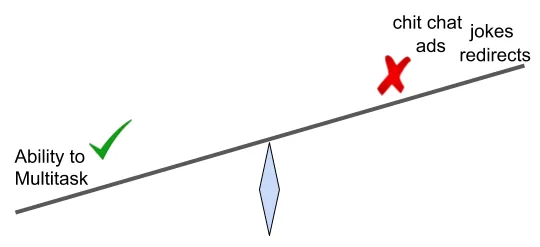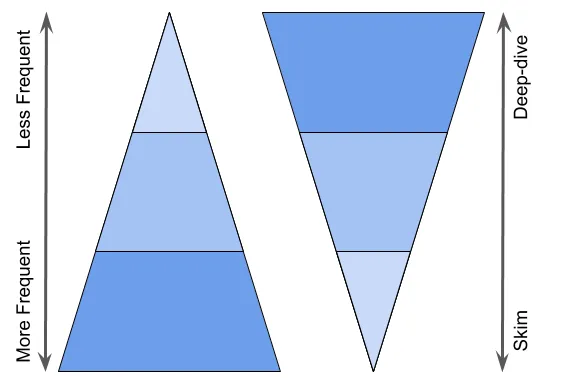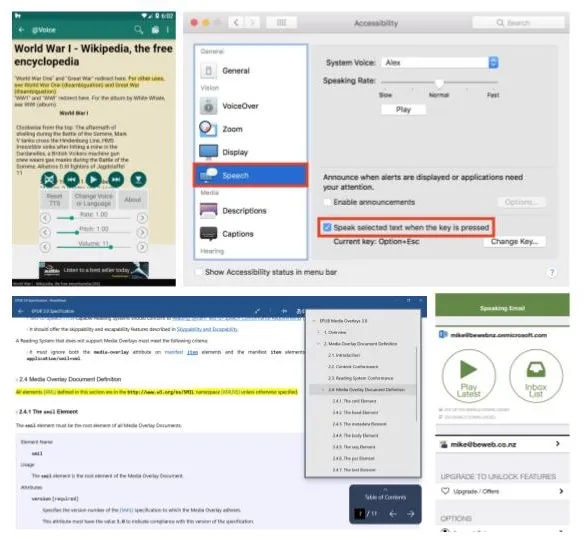Knowledge workers have a sort of Achilles heel to the value they bring to the table - by the time they’ve published a research paper or a patent, it is legacy and not the latest; by the time they’ve completed a tech project, your project is already in need of modernization. This brings up the need for constant upskilling, in my opinion. Most successful Product Managers and tech stalwarts I’ve met tackle this well through their neverending desire to learn and improve themselves, which has always been an inspiration to me.
One area of constant “keeping up” is being aware of the newest go-to-market strategies, marketing approaches, and technological innovations that make it possible to achieve product-market fits and technological accomplishments that weren’t possible before.
I’d primarily started this post to share my information sources as a curated list but ended up adding more of “how” and “why”. To keep the post short, I’ve split the curated list into a follow-up post.
Retrospecting and Establishing Base Principles
I’ve tried over 35 information sources but I use only 15 of them, having rejected the rest. A coincidental conversation with my mentor made me retrospect and understand a pattern to my preferences. Here are the base principles I’ve established after understanding my pattern of usage. In my follow-up article, I’ll define use these base principles as KPIs and score each information source on them.
I optimize for the following criteria when I’m choosing a source of information:
Information medium
Mutually Exclusive
Efficiency
Pricing
Skimmable breadth of coverage
Depth in relevant skills

Explaining the Base Principles
Let me explain these base principles:
Information Medium: Options are audio, video, and text. Within text, there are email and webpages. I arbitrage by using TTS software to read out email newsletters as my primary medium and podcasts as my secondary medium. I don’t consider books as an information source of things going on in the world but rather as holders of knowledge, which need not be read to keep “up to date” but rather to “keep learning”. I prefer audio over video or text as audio allows for multi-tasking while allowing the usually-fatigued eyes to rest and let us rely on another of our five senses.

Mutually Exclusive: I try to set up my stack such that my information sources overlap as little as possible. I’ve borrowed this terminology from the MECE principle used in strategy consulting.
Efficiency: I aim to make my information intake efficient by minimizing non-information. So, I choose sources with as little as possible of jokes, ads, redirects, or chit chat. Another dimension I measure efficiency is in terms of the ability to multitask, which is why I prefer audio over video or text.
Pricing: I look to spend as little as possible on these information sources and divert that spending power (think opportunity cost) for books, online courses, and so on. The world changes every day and a huge number of sites capture the latest and greatest at a sufficiently good quality that I’ve not found a need to pay.

Skimmable breadth of coverage: There are a lot of topics where knowing the headline works sufficiently for me, so I choose some sources of information with headlines.
Depth in relevant skills: There are some areas like Entrepreneurship and Product Management, where I try to understand more in-depth information so I choose sources accordingly.

The relation between point #5 and #6 can be seen in the above reflective pyramid structure where the most frequent sources contain skimmable breadth of content and the sources containing deep-dive are least frequent.
Newsletters, Podcasts, Blogs, and more
Now with a set of principles to prioritize between sources of information, we can discuss selecting amongst stereotypical information sources. This is a high-level look into the stereotypical examples of these information sources.
Blogs? Consider blogs like Technology Curation on Medium. You would get lots of opinions from folks from varying authority levels and varying quality - the blogosphere is host to some of the top tech writers but also to freelancing writers in specific niches like yours truly. I choose to not read blogs on a daily basis because of the time spent reading in-depth in each article and at the same time most blogs often not having a novel piece of information or perspective to it.
Websites? Similarly, consider websites such as WSJ or TechCrunch - you would get a lot of information, but also the efficiency is low due to journalistic flair and SEO. As a reader, Journalistic flair results in you being presented not only with the headline but also with a lot of backstories that might be redundant for you if you read frequently. Writers cross-link existing articles to a lot of other articles, something that helps SEO, but in turn, this makes it likely for you to deviate from reading the latest pertinent information to other articles or even fall for click-bait. So I choose to not read websites on a daily or weekly basis.
Podcasts? Out of the varieties of Podcasts, I have tried News podcasts and topic-specific podcasts. I recently started using podcasts after finding out there is a way to increase the playback speed of podcasts, since I’ve noticed I pay more attention (and of course can hear more in the same amount of time) when it is fast. Having heard from many friends and colleagues that their attention sways when listening to something passively, I would suggest speeding up the playback to 1.5x or 2x if you’ve felt a similar lack of concentration from listening to podcasts. I’ve recently reduced my reliance on news-style podcasts because a story that could be summarized as a headline is discussed elaborately, includes speculations of next moves, provides very incremental information, and brings in opinions (i.e. not facts) of journalists. In-depth podcasts or curated news podcasts work well as the former adds to the “in-depth” bucket and the latter overcomes some of the fallacies of the daily news podcasts. As an audio format, podcasts work well to not overwhelm tired eyes and allow multitasking.
Newsletters? Given the variety of newsletters out there, I find it feasible to pick ones to build a stack that is mutually exclusive, efficient, et al. However, newsletters are individual emails with additional header and footers (inefficient) and are text-based. I noticed that I would end up skimming newsletters that are information-dense and would often get distracted in between my reads if it were a longer article. Lastly, newsletters provide links for further reading, which made it an easy time suck. So, I’ve instead chosen to use text to speech (TTS) software on Windows, Mac, or Android to read out newsletters aloud. As an audio format, TTS of newsletters works well to not overwhelm tired eyes and allow some amount of multi-tasking.
Books? As I mentioned earlier, in my perspective, books are not intended to keep you up to date with the latest functional skills or news on a daily, weekly, or monthly basis. You might read a book that got published today but not learn anything new. You might read a book published 20 years ago and yet learn new skills. So, books are not one of the information mediums I have curated to build a stack to keep myself up to date.
The TTS Arbitrage
In case the text to speech accessibility arbitrage sounds interesting to you, here are the tools I have found helpful for it:
Android: I use the @Voice Aloud app and copy and share text from emails to the app. I’ve also found the Speaking mail app helpful but it frequently faces technical glitches and is built to skip over newsletters rather than focus on them.
Windows: I use the ReadAloud app. I copy-paste multiple newsletters from an email client into the app and let it read out the newsletters.
Mac: I use the in-built narrator by selecting all text in an email in an email client and reading it out.
iPhone: I don’t use an iPhone so haven’t tried things out there. Whoops…

What’s in Part 2 and 3 - Curated Lists
In Part 2, I will show a curated list of recommended information sources and in part 3, I will show a list of rejects. I’ll explain the reasoning for liking and rejecting sources. Lastly, I’ve scored each information source on the KPIs we saw above and I’ll visualize the scores in the next post.
Hope the above helped you introspect into your preferences for consuming information regularly and helps you weed out some sources to save you time.